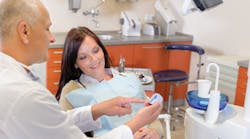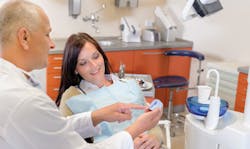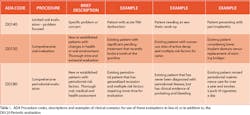by Karen Davis, RDH, BSDH
We've all felt frustrated! It seems like the exam portion of the hygiene visit often leads to increased stress. See if either of these scenarios sounds familiar:
The clinical assistant and dental hygienist are getting anxious since it took forever to get the doctor into the hygiene appointment, and now it's taking forever to get the doctor out…
The patient is frustrated after waiting 10 minutes beyond her appointment time for the doctor to complete a 60-second exam that costs $40…
While there's no easy fix to these common frustrations, there are steps to make the doctor-patient examination more valuable and less stressful for all concerned. But here's a warning! Some of these concepts may take you out of your comfort zone, and some may require practice in order to go smoothly and feel natural. Here are a few strategies to help you create your own ultimate exam within the dental hygiene appointment.
1. Use screenings to determine diagnosis while practicing the art of prioritization.
In practice after practice, dental hygienists are desperately attempting to educate patients, change behavior, scale supra- and subgingival calculus, remove all stain and plaque, perform and record periodontal evaluations, perform CAMBRA, update radiographs, apply fluoride, discuss restorative and esthetic concerns, and so on, all in ONE appointment that lasts 40 to 60 minutes, IF the appointment starts on time! Sound impossible? It often is.
Learning the art of prioritization enables dental hygienists to proceed through conditions, and then prioritize procedures for the day's visit while treatment planning for subsequent visits. Mastering this concept is good time management, and it helps determine appropriate services. Some patients scheduled for a prophylaxis actually present with evidence of active periodontal infection, so they may require additional diagnostic data to confirm a diagnosis and present a treatment plan. Additional services and procedures can be completed during subsequent visits, such as use of a shade guide to discuss whitening options or implementing caries risk management strategies.
The challenge for many dental professionals is letting go of the idea that everything should be accomplished in one visit. When attempting to cram too much into one visit, patients may seem dazed as they exit the treatment room, and they may feel that things were rushed.
Dental hygienists can refine the art of prioritization as they proceed through the various screenings, identify the priorities for today's visit, and carefully treatment plan priority procedures for the next visit. Here's an example of screenings used to identify priorities:
a) Screening for any known sensitivity
b) Medical history update including risk assessments for disease
c) Blood pressure screening
d) Radiographic assessment to update or review previous films
e) Oral cancer screening including intra- and extraoral exam and use of adjunctive screening technology, as indicated
f) Periodontal screening including an annual comprehensive periodontal assessment as recommended by the American Academy of Periodontology1, and salivary diagnostic tests, as indicated
g) Caries management by risk assessment (CAMBRA) including caries detection technology and interventions to lower risk and implement remineralization strategies
h) Restorative and esthetic screening including identification of occlusal disease
During data collection, priorities will begin to emerge that enable the clinician to provide treatment based upon diagnosis. Sometimes what appears a priority based on a past clinical chart gets completely overridden by different priorities.
------------------------------------------------
Other articles by Karen Davis
- Keeping periodontal maintenance relevant and positive
- Finding humor in dental stem cell collection and storage
- Do You Know About Air-Flow Perio?
------------------------------------------------
Here's an example. Beverly's chart states that at her next visit, the dental hygienist would provide the oral cancer screening using the adjunctive technology Identifi®. It has been slightly more than two years since her bitewings were updated. However, Beverly arrives 15 minutes late and upon examination the dental hygienist notices a very dry mouth and a fractured resin restoration. But Beverly's biggest concern is to know more about Invisalign®. What are the highest priorities for the visit today? What does the dental hygienist defer to the next visit?
Decisions like this happen almost hourly with dental hygiene appointments. The answers are different depending on each situation, but unless one has developed the art of prioritization, this scenario leads to the dental hygienist trying to accomplish too much in one visit, and everyone feels rushed. One way to approach the scenario with Beverly is to recommend that the next restorative appointment include time to not only repair the broken resin, but to update and examine the bitewings and scan the patient for Invisalign. If additional diagnostic information is required for consideration of Invisalign, D0140, limited oral evaluation can also be used. This enables the dental hygienist to streamline the priorities for today's visit and meet the patient's needs.
2. Identify candidates for more comprehensive examinations.
The most common examination provided during dental hygiene visits is the periodic oral evaluation, insurance code D0120. While that type of exam is often appropriate for continuous-care patients visiting for preventive or maintenance procedures, dental hygienists should identify when other types of exams are indicated.
Let's look at a scenario where another exam would be beneficial. The dental hygienist sees Joseph, who inquires about tooth whitening, but upon examination the RDH identifies several stained class I restorations on Joseph's upper anterior teeth and visible abfraction lesions and wear facets on his posterior teeth. The dental hygienist uses an intraoral camera to take pictures of the stained resins, abfraction lesions, and wear facets. She presents the idea that in some cases porcelain veneers are best for teeth like Joseph's in the upper arch, while whitening is appropriate for the lower arch.
Telling the patient this may go as follows: "Joseph, what Dr. Jones generally recommends in a situation like yours is for the two of you to set aside time for her to perform a more detailed examination of your bite and determine which procedures are best to enhance your smile. There are actually several options available, so it would be advantageous to look carefully at your bite and determine what will give you the best outcome."
During the dental hygiene appointment, the RDH discovers that Joseph also presents with evidence of early demineralization, so her priority during the visit is to perform CAMBRA and implement strategies for remineralization. The patient is rescheduled to see the dentist for D0140 limited oral evaluation, in which diagnostic casts are taken and occlusal disease is assessed. Joseph's treatment plan includes porcelain veneers for Nos. 5 through 12, Philips Zoom® Whitening for the lower arch, and an occlusal guard to protect his smile. Using the D0140 evaluation to gather current diagnostic information and discuss the pros and cons of various treatment options enables Joseph to make a well-informed decision about how best to enhance his smile. Table 1 presents three clinical oral evaluations as described by the ADA, and examples of when these types of evaluations would be advantageous in lieu of or in addition to the D0120 periodic oral evaluation.
3. Don't wait until the last five minutes of the appointment to give the exam.
Time management is a challenge when taking care of patients' health needs, answering their questions, and providing treatments within a wide range of clinical conditions. In most busy dental practices, waiting until the dental hygienist is completely finished before notifying the doctor for an exam almost guarantees you'll run behind. It's often impossible for the doctor to immediately leave a procedure to examine a dental hygiene patient. The result? Everybody waits, and a domino effect takes place within the schedule. Notifying the doctor once data has been collected and treatment discussed enables the doctor to look for a natural break in a procedure and perform the exam. This approach requires dental hygienists to get in the habit of notifying the doctor after the data collection and clinical discussion, but prior to beginning instrumentation.
4. Use visuals to replace wordy descriptions.
Patients will understand and retain information much better if audible and visual learning takes place together. Instead of doing all of the talking (while working on the patient with sharp instruments), we should let "a picture speak 1,000 words" for us. Intraoral pictures, before-and-after photos, educational pamphlets, radiographs, and periodontal charts help patients understand and desire recommended treatment. When looking at an intraoral picture together, ask, "Do you see the crack in your tooth?" or "Do you see the wear on this tooth where the enamel is gone?" giving patients a sense of ownership about their conditions. Sometimes dental professionals have a tendency to use terms that are too technical and describe more detail than most patients really need. Effective treatment enrollment takes place when both the patient and clinician see what's going on in the patient's mouth.
5. Sit the patient upright for communication.
If you have been a patient in the dental chair, you know how uncomfortable it can be to carry on a conversation with someone who is seated above you with protective barriers covering their face. Studies have shown that as apprehension rises, listening ability diminishes. Patients often begin their hygiene visit apprehensive about what you're going to tell them. Laying them back in a supine position and adding sharp instruments to the scenario increases their potential for apprehension. Yet most clinicians begin to multitask and use the opportunity to educate patients. If you're willing to pause, sit the patient upright to discuss possible treatment, educate them, and use visuals, you'll find you actually have to say less because their ability to retain information is significantly greater with good eye contact and body positioning. Sitting the patient upright also enables clinicians to become better listeners as patients feel more comfortable discussing their concerns.
6. Use a "triangle of communication" for the dental hygienist's synopsis of findings.
When the dentist enters the hygiene treatment room for the exam, generally the first thing that happens is an exchange of social graces and an update about any concerns the patient may have. Often during the social graces the hygienist is busy writing chart notes and is not part of the examination. Because it is important for the patient to hear the dentist ask the hygienist for his or her findings, the dentist might say something like, "So Cindy, how did everything look in Barbara's mouth today?"
This is the dental hygienist's cue to enter into a triangle of close communication between the patient, dentist, and hygienist. The hygienist should give a brief description of diagnostic data collected, discussion about potential treatment, and a synopsis of the patient's response. An easy way to be consistent in delivery of this information is to remember the acronym DDR, which stands for data, discussion, and response.
Here is an example of the dental hygienist's synopsis. Notice inclusion of DDR. "Barbara was a great patient today. The periodontal screening revealed several areas of localized periodontal infection in her mouth. Barbara is concerned because both of her parents lost their teeth around age 50 and she hopes to keep hers for a lifetime. We have discussed the benefits of periodontal therapy to stop the infection from progressing, and she is prepared to return for that treatment right away. In addition, Barbara still has tooth No. 19 that you previously recommended a more secure restoration for, but because it is asymptomatic she actually forgot about it. I have a new intraoral photo of that tooth that shows the vertical fracture lines, and she'd like your input on how urgent you think this condition is. Lastly, Barbara has experienced some generalized sensitivity, so we'll apply fluoride varnish today and she is taking Fluoridex home to begin daily use."
The advantage of this "triangle of communication" is threefold:
a) The patient hears the dentist ask for the synopsis and value the dental hygienist's input.
b) The hygienist and the dentist have a professional exchange of information about the patient, in front of the patient, ensuring that the patient hears the same synopsis.
c) The dentist knows the priorities for an examination to be thorough and concise.
In the scenario, did you notice the use of the patient's name? This is another way to increase the attentiveness of the patient, as we all tend to pay attention when someone talks about us in our presence. Once the dentist confirms any diagnosis with the patient, a directive should be given for the time frame the patient should proceed with treatment. The dental hygienist can cue the dentist by asking, "Dr. Jones, how soon would you recommend Barbara proceed with this treatment?" In the hand-off to an administrator for financial discussions, it is advantageous for the hygienist to repeat the time frame the doctor has recommended.
Having an ultimate experience requires planning and forethought, but the rewards of being deliberate about how we approach this important time allotment in the dental hygiene appointment can directly lower stress throughout the practice, increase the patient's understanding, and most importantly, improve case acceptance to achieve the optimal clinical results we want for all our patients. RDH
KAREN DAVIS, RDH, BSDH, is the founder of Cutting Edge Concepts, an international continuing education company, and practices dental hygiene in Dallas, Texas. She is an independent consultant to the Philips Corp. and serves on the review board for Dental-antioxidants.com. She can be reached at [email protected].
References
1. Comprehensvie Periodontal Therapy: A Statement by the American Academy of Periodontology. J Periodontol 2011








